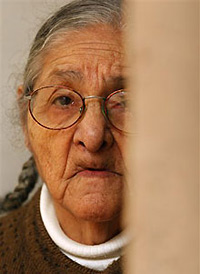 |
 |
 |
 News Around the Republic of Mexico | January 2006 News Around the Republic of Mexico | January 2006  
Mexico City Police Stumped by Serial Killer Targeting Elderly Women
 Ioan Grillo - Associated Press Ioan Grillo - Associated Press


| | Jovita Garrido Lopez, 91, of Mexico City, looks out from her doorway in a working-class Mexico City neighborhood Tuesday. The Lopez family keeps a close eye out for Jovita, after a wave of murders of elderly women has gripped the city. (AP) |
Mexico City – The killer is either a cross-dressing man or a robust woman who strangles elderly women with stockings or telephone cables.

Mexican police believe the so-called "Mataviejitas," or "Little Old Lady Killer," has killed at least seven elderly women in the country's bustling capital of 20 million, although they are investigating whether 22 other slayings of older Mexico City women since 2003 are also related.

The slayings have captured the imagination of tabloid-style papers and news stations in recent months, while terrorizing older residents in a city already plagued by kidnappings and crime. They have also brought fresh criticism of a police department and justice system that leaves the vast majority of crimes unsolved and unprosecuted.

Police say the killer struck most recently in October. Witnesses have described a masculine figure in a dress near the scene of some of the crimes, indicating the killer may be mimicking another serial killer in France – the Monster of Montmartre, a transvestite who strangled or bludgeoned to death 21 elderly Parisian women between 1984 and 1987.

Investigators believe the killer probably tricks his or her way into the victims' homes by posing as a nurse or government worker, then kills the women and ransacks their places. In most cases, only small objects such as crucifixes and rings have been stolen – perhaps as trophies, a feature common with serial killers, police say.

Another clue linking the killer to France is that three of the victims all had copies of the same painting – an 18th century portrait called "Boy in Red Waistcoat" by French artist Jean-Baptiste Greuze. The canvas, which was popular in Mexico in the 1970s, shows a feminine-looking boy in a frilly red tunic.

Criminologist Miguel Ontiveros, who constructed a psychological profile of the killer, said he believes the paintings are no coincidence.

"The feminine boy in the waistcoat could be connected to a murderer who has a sexual identity crisis," Ontiveros said.

Ontiveros also believes the killer has a hatred for old women, probably stemming from a bad childhood experience, such as sexual abuse.

With all of the media attention, Mexico City police have been under increasing pressure to solve the case, even turning to their Parisian counterparts for training on how to protect evidence and seal off crime scenes.

"He or she acts with a lot of skill, gaining the confidence of the victims and leaving few clues," Mexico City Attorney General Bernardo Batiz said of the killer, who he characterized as having "brilliant intelligence."

But some experts blame corruption and ineptitude among Mexican law enforcement officials for their inability to catch the killer.

"The bungling of this investigation sends a message to the public that the police do not protect you and you better be worried," said Rene Jimenez, an expert on social violence at Mexico's National Autonomous University.

Some Mexican officers simply don't know how to protect crime scenes, said Jose Luis Perez, who directs the Mexico City detective training center where the French police gave their courses.

"There are police who touch things and leave prints and then we waste time investigating false leads," Perez said.

Authorities have handed out 1 million fliers to elderly residents in the city, warning them to keep their doors closed to strangers. Many residents fear the killer will strike again.

Maria Teresa Torres, 81, said she recently installed an eyehole in her door so she could see who was calling.

"Why does this beast want hurt to us?" asked Torres, who lives alone, like about 10 percent of the 500,000 elderly women in Mexico City. Patting her pet terrier she added, "My peluza will defend me." | 
 | |
 |



